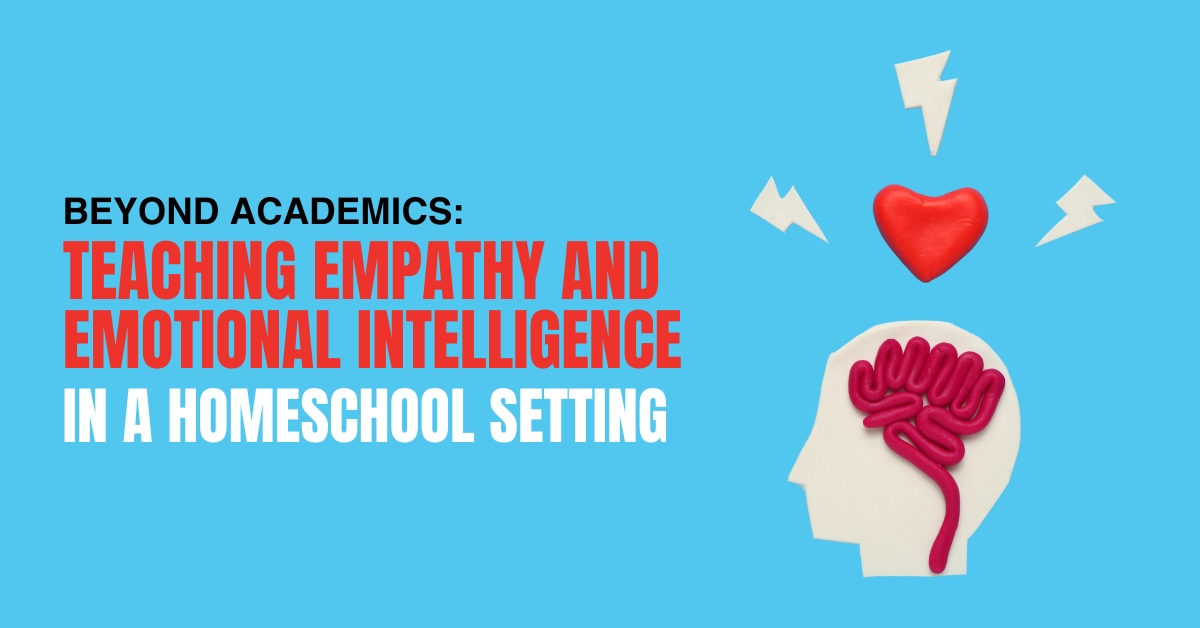In today’s fast-paced, digitally-driven world, academic knowledge alone is not enough to prepare children for the future. While math, science, and history are important, equally vital are the abilities to understand, empathize, and connect with others. Homeschooling offers a unique opportunity to integrate these emotional skills into daily learning. This blog post will explore how homeschooling parents can teach empathy and emotional intelligence to their children, ensuring they are well-rounded individuals ready to face life’s challenges.
Creating An Emotionally Intelligent Learning Environment
Teaching empathy and emotional intelligence in children is crucial. These skills enable children to build meaningful relationships, manage their emotions effectively, and make thoughtful decisions. In a homeschool setting, parents have the freedom to tailor lessons and activities that foster these abilities, giving their children a head start in developing strong interpersonal skills. Research has shown that children who possess high emotional intelligence are more likely to succeed academically and socially. They tend to have better mental health and stronger relationships and are more resilient in the face of adversity. By focusing on these skills, homeschooling parents can provide a holistic education that prepares their children for all aspects of life.
Creating an environment that promotes emotional intelligence in children starts with the parents. Homeschooling parents should model emotionally intelligent behaviors by demonstrating empathy, active listening, and emotional regulation in their daily interactions. Children learn by observing and seeing these behaviors in action, which helps them understand how to apply them in their own lives. Incorporating regular discussions about emotions and encouraging open communication is another effective strategy. Parents can ask their children about their feelings, validate their emotions, and provide guidance on how to manage them. This practice not only helps children become more self-aware but also strengthens the parent-child bond.
One of the advantages of homeschooling is the ability to integrate lessons on empathy seamlessly into the curriculum. For example, literature and history lessons can be used to teach empathy by exploring characters’ emotions and motivations. Discussing the experiences of historical figures and fictional characters allows children to see the world from different perspectives and develop a deeper understanding of others. Parents can also use role-playing activities to teach empathy. By acting out various scenarios, children can practice putting themselves in others’ shoes and learn how to respond compassionately. This hands-on approach makes the concept of empathy more tangible and relatable.
The Role Of Social-Emotional Learning (SEL) Programs, Service Learning, & Emotional Literacy
Social-Emotional Learning (SEL) programs are designed to teach children essential life skills such as self-awareness, self-management, social awareness, relationship skills, and responsible decision-making. Homeschooling parents can incorporate SEL activities into their daily routines to nurture emotional intelligence in children. These activities can include mindfulness exercises, journaling, and collaborative projects that require teamwork and communication. By incorporating SEL into the homeschool curriculum, parents can ensure their children develop the emotional competencies needed for success in all areas of life.
Service learning is an educational approach that combines learning objectives with community service. It provides a unique opportunity for children to develop empathy by engaging in activities that benefit others. Homeschooling parents can organize service projects that allow their children to interact with diverse groups and understand different life experiences. Examples of service learning projects include volunteering at local shelters, participating in community clean-ups, or organizing fundraisers for charitable causes. These activities not only teach children how to teach empathy but also instill a sense of civic responsibility.
Emotional literacy involves recognizing, understanding, and expressing emotions effectively. Homeschooling parents can promote emotional literacy by using tools such as emotion charts, storytelling, and art activities. These tools help children identify and articulate their feelings, which is a crucial step in developing emotional intelligence. Reading books that focus on emotions and discussing the characters’ experiences can also enhance emotional literacy. By engaging in conversations about emotions, parents can help their children build a robust emotional vocabulary and improve their ability to express themselves.
Mindfulness practices, such as meditation and deep breathing exercises, can also significantly enhance emotional intelligence in children. These practices help children become more aware of their emotions and develop the ability to regulate them effectively. Homeschooling parents can incorporate mindfulness into their daily routines to create a calm and focused learning environment. Starting the day with a short meditation session or taking mindful breaks between lessons can help children manage stress and improve their concentration. Over time, these practices can lead to greater emotional resilience and overall well-being.
Building Positive Relationships & Conflict Resolution Skills
Building positive relationships is a key component of emotional intelligence. Homeschooling parents can facilitate this by encouraging social interactions and fostering a sense of community. Playdates, group activities, and extracurricular classes provide opportunities for children to practice their social skills and build meaningful connections. Parents can also teach their children the importance of kindness, cooperation, and respect in relationships. By modeling these behaviors and reinforcing them through positive reinforcement, parents can help their children develop strong interpersonal skills.
Conflict is a natural part of life, and learning how to resolve conflicts peacefully is an essential skill. Homeschooling provides a controlled environment where parents can teach conflict resolution techniques. These techniques include active listening, empathy, and collaborative problem-solving. Parents can use real-life situations or hypothetical scenarios to practice conflict resolution with their children. By guiding them through the process, parents can help their children develop the skills needed to manage disagreements constructively.
The Impact Of Parental Involvement And Overcoming Challenges
Parental involvement is a significant factor in the success of teaching empathy and emotional intelligence in children. Homeschooling naturally involves a high level of parental engagement, which can be leveraged to reinforce these skills. Parents who are actively involved in their children’s education can provide consistent support and guidance, making the learning process more effective. By being present and attentive, parents can create a nurturing environment where children feel safe to express their emotions and explore new ideas. This supportive atmosphere is essential for developing emotional intelligence.
Teaching empathy and emotional intelligence in children can present challenges, particularly for homeschooling parents who are already juggling multiple responsibilities. However, with persistence and creativity, these challenges can be overcome. Parents can seek support from homeschooling communities, online resources, and educational professionals. Sharing experiences and strategies with other parents can provide valuable insights and encouragement. Additionally, parents can continue their own education by attending workshops and reading literature on emotional intelligence and empathy.
Technology can also be a powerful tool for teaching empathy and emotional intelligence in children if used wisely. Educational apps, online courses, and virtual social groups offer additional resources for homeschooling parents. These tools can provide interactive and engaging ways to explore emotions and social skills. However, it’s essential to balance screen time with real-world interactions. Ensuring that children have ample opportunities for face-to-face communication and hands-on activities is crucial for their emotional development.
Essential Learning Skills
Incorporating empathy and emotional intelligence into a homeschooling curriculum is not just beneficial—it’s essential. These skills equip children to navigate the complexities of life with confidence and compassion. By creating an emotionally intelligent learning environment, integrating empathy into daily lessons, and actively involving themselves in their children’s education, homeschooling parents can cultivate well-rounded individuals ready to contribute positively to society. If you’re a homeschooling parent looking for more guidance on how to teach empathy and emotional intelligence in children, consider reaching out to educational professionals or joining a supportive community of like-minded parents. Together, we can raise a generation of emotionally intelligent, empathetic, and resilient individuals. Remember, the journey of teaching empathy and emotional intelligence is ongoing. Each step you take brings your child closer to becoming a compassionate and understanding adult. Keep exploring, keep learning, and most importantly, keep nurturing those precious emotional connections.





